Following a banner year of strong, applications, and after much deliberation, we are pleased to…
By Professor Evan Crump
On the first weekend of October, I accompanied two classes of English 101 students, both of them populated by Early College students still in high school, to the National Mall to experience exhibits at the Air & Space and Natural History museums. Their goals were threefold: first, to gather information and resources for a group presentation connecting one or more exhibits to science fiction media and their own research; second, to find exhibits that connected to their personal reading and viewing choices in the sci-fi genre for a future research paper on fictional technology; and third, to find inspiration for a sci-fi short story they will be writing later in the semester.
Following the visit, students were asked to respond to three short-answer questions debriefing their experience. They also contributed photos they took while exploring the museums. Some highlights from those responses follow.
Question #1: What were you hoping to discover/learn/experience on your Smithsonian visit?
I was hoping to find information on prehistoric life and why certain animals had features that the animals today do not. I also wanted to find out why animals were so much bigger back then compared to now. – D.

I knew there was a big emphasis on fossils in the museum so I expected to see a lot of dinosaur or early human fossils. I knew there was a lot of geological stuff in the museum but I wasn’t too enamored with the idea of staring at rocks. – K.

I was hoping to discover or learn more about fossils and dinosaurs. The thought of the Jurassic period always catches my attention because of the movie, Jurassic Park. – M.
I was hoping to learn more about potential alien life on other planets, or learn more about planets outside our solar systems in general. – C.
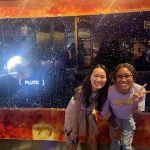 On this trip, I was hoping to learn more about extraterrestrial life and the impact human beings have had on Earth thus far. I had really wanted to experience the planetarium in the Air and Space museum, and also learn about a few exhibits on climate change and human evolution. – T.
On this trip, I was hoping to learn more about extraterrestrial life and the impact human beings have had on Earth thus far. I had really wanted to experience the planetarium in the Air and Space museum, and also learn about a few exhibits on climate change and human evolution. – T.
Question #2: How did your experience at the museum meet/exceed/change your expectations?
I found out about the survival capabilities of animals that were bigger back then and why they survived better than today’s counterparts…. I also found out about the extinctions that occurred because of the unsustainability of the giant animals. One of the exhibits talked about why Neanderthals ultimately went extinct while humans survived. – D.
I thought I would only get information about the Mars rover and the weather conditions on Mars but I got step by step details on how the whole process of Mars and why we started exploring. – M.
I stared at the rocks. The geological exhibit was really interesting and blew me away with how cool it actually was! Seeing the huge gemstones was also really cool and was something I didn’t expect. One exhibit I didn’t know was even there but I absolutely adored was the African history exhibit. I really love history so seeing an exhibit focused on history that isn’t really explored in current curriculum’s was super cool! I loved seeing the mud houses and some of the actual African utensils in the exhibit. – K.
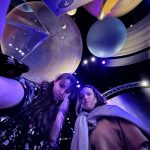 There were a few exhibits based around the characteristics of planets (though most of them talked about our own solar system), and even one discussing the habitability of particular planets. There was another display discussing hostile environments on other planets, and what factors would indicate suitability for life that I found informative. – C.
There were a few exhibits based around the characteristics of planets (though most of them talked about our own solar system), and even one discussing the habitability of particular planets. There was another display discussing hostile environments on other planets, and what factors would indicate suitability for life that I found informative. – C.
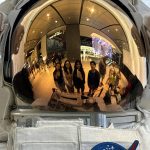 It felt like I was going on a trip through time in the Destination Moon exhibit. – R.
It felt like I was going on a trip through time in the Destination Moon exhibit. – R.
I was…able to learn the political background and ramifications of many of these monumental attainments by humanity which would help to satiate my desire for political and historical knowledge. – J.
I found exhibits that I didn’t necessarily think would connect to what I was looking for, such as the exhibit on Light Pollution, and found interesting information about auroras and how much the night sky has changed over time, which was actually somewhat relevant to some of the science fiction media I have recently consumed. – T.
Question #3: What exhibits are you excited about incorporating into your future work for this class and why?
 I plan to use the human ancestry exhibits as well as the extinct life exhibits as they talk about why animals go extinct and how humans play a role involving nature. These exhibits can also explain some of our psychology that will play a role in the Sci-Fi media that I have chosen such as dystopian stories like Station 11 as well as Jurassic Park. – D.
I plan to use the human ancestry exhibits as well as the extinct life exhibits as they talk about why animals go extinct and how humans play a role involving nature. These exhibits can also explain some of our psychology that will play a role in the Sci-Fi media that I have chosen such as dystopian stories like Station 11 as well as Jurassic Park. – D.
The exhibits I am most excited about incorporating were the mammals and the fossil exhibits, because I want to focus on the evolution of life, and these exhibits helped relate humans to their primitive ancestors and how every other species’ anatomy, every species evolved differently to suit their environments, so I want to discuss how we as humans will also evolve. – S.
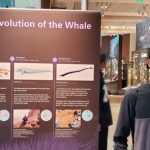 A lot of the sci-fi I’ve engaged with features technology similar to some of the inventions we’ve developed (such as more advanced versions of cellphones or wireless earbuds), and one in particular discusses alien life in depth on another planet. – C.
A lot of the sci-fi I’ve engaged with features technology similar to some of the inventions we’ve developed (such as more advanced versions of cellphones or wireless earbuds), and one in particular discusses alien life in depth on another planet. – C.
I am excited about incorporating the research on if there is water on other planets into my research project for Dune. – R.
There was one exhibit in ‘Deep Time’ at the Natural History museum about mass extinctions that I look forward to incorporating into my future essays about the media I plan to consume, as the mass extinction of humanity and what remains afterwards is a big theme in my choice of media. The exhibits on light pollution and planetary exploration are also ones that I would really like to incorporate into my work somehow, because light pollution is something I am personally fascinated and concerned by, and planetary exploration is another fairly big theme in much of science fiction media. – T.
Based on these responses, students’ experiences at the museum were overwhelmingly positive, and they emerged with enthusiasm for incorporating their experiences into both their group project and their personal research and writing.
My impression is that giving students choices of which museum to attend, what to explore while there, and how to incorporate their findings into their future projects (which also have significant student agency in form and content) empowered them to approach this experience as their own journey rather than a humdrum academic requirement. While certain exhibits were clear fan favorites, notably Destination Moon, the Ocean Hall, and Exploring the Planets, there was surprising diversity in their exploratory choices, and I am excited to see what they’ll come up with to connect sci-fi media to, say, Gems & Minerals or Nation of Speed. One of my favorite things about teaching is learning something new from my students, and I bet in the coming weeks I’ll be doing just that.




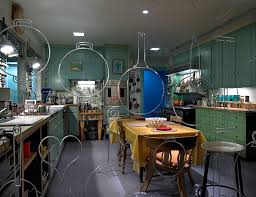
This Post Has 0 Comments